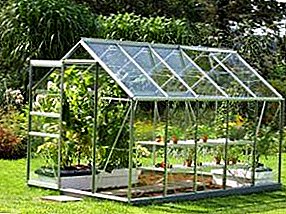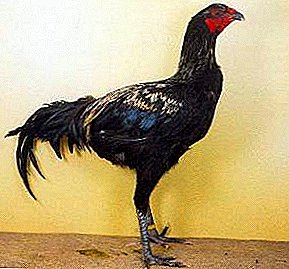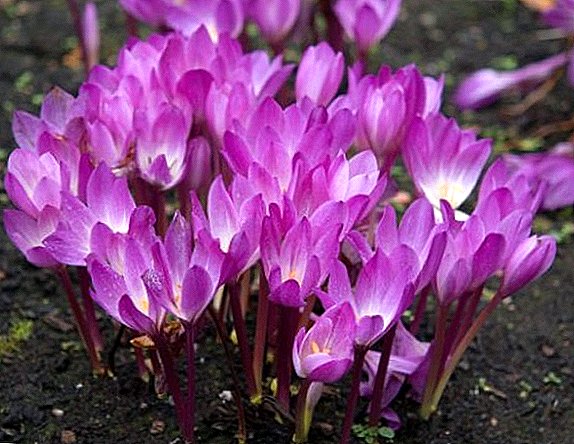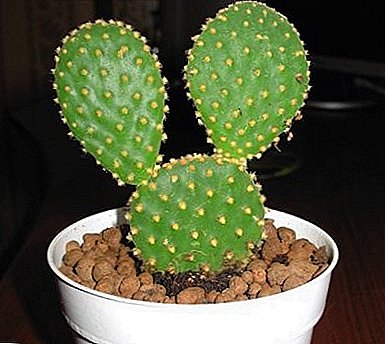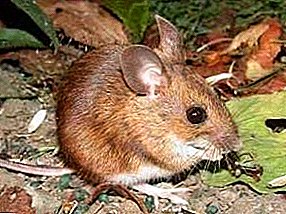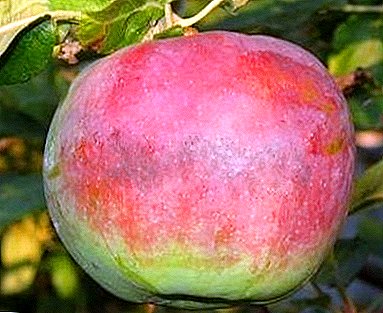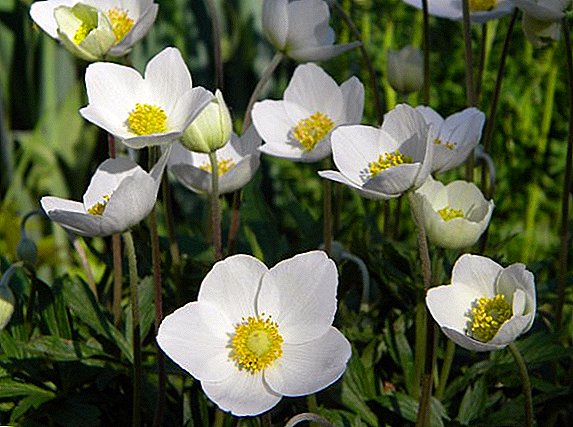 In this article we will get acquainted with such a plant as a wood anemone, consider its photo and description, the rules for caring for it, as well as useful properties that the flower abound.
In this article we will get acquainted with such a plant as a wood anemone, consider its photo and description, the rules for caring for it, as well as useful properties that the flower abound.
Botanical description
Anemone forest - novice gardeners can not often hear this name. But it is necessary to show the flower or to voice its name in Latin ("anemone sylvestris"), as everything at once becomes clear. Forest anemone is the most common anemone that is familiar to the ear and eyes.
Did you know? There is an assumption that the flower got its name from the Greek word "anemos", which means "wind". Because when the wind blows, the anemone supposedly closes, hides from the gusts and thus explains its name.The flower belongs to perennial herbaceous plants, has a short but thick rhizome. Its stems are low - only 5-15 cm. Basal leaves, which are from two to five in a flower, are collected in a socket at the very base of the stem. They are on long petioles, palmate-shaped, usually three- or five-segmented, the segments of which are of rhombic form with jagged edges.
 The flowers themselves are single, have a white color of petals and a yellow heart-core, and their diameter reaches from 2 to 7 cm. If we talk about the plant as a whole, you cannot call it single - anemones grow in heap groups, hiding the ground under the fluffy leaves that look like parsley .
The flowers themselves are single, have a white color of petals and a yellow heart-core, and their diameter reaches from 2 to 7 cm. If we talk about the plant as a whole, you cannot call it single - anemones grow in heap groups, hiding the ground under the fluffy leaves that look like parsley .Anemone forest blooms later than other anemones - its flowering begins in the middle - the end of May, and ends by the middle of July. On average, it blooms for about 25 days. In August, the anemone blooms again, and the fruits appear in June.
The numerous fruits of the anemone are similar to small oblate nuts, up to 3 mm in size, the stamens are short and have a rich yellow color.
Did you know? The people are anemone known as night blindness, white sleep or field bells.It belongs to the flower of the buttercup family.

Habitats
You can meet anemones in nature quite often. Places where anemones grow are easy to find. The plant chooses dry areas for life, where the soil is not oversaturated with moisture, with a temperate climate — forest edges, steppes, meadows, shrub slopes, sparse oak and coniferous forests, as well as stony precipices.
In nature, anemone lives in the forests of Europe, Central Asia, Western and Central Siberia, as well as in Mongolia, China, Ukraine, Belarus, European parts of Russia and the Caucasus.
Forest anemone - the only type of anemones that easily take root in sandy soils and develop favorably in such areas.
Important! Nevertheless, the loose earth soil fits no less, and it blooms on it more luxuriantly and brighter.A flower of this variety is more demanding on the structure of the soil than other anemones. It cannot grow on wet soils near water bodies and, especially, on their banks. She needs a light sandy, peaty or carbonate soil.

Conditions for growing in the garden
It is possible to find a flower not only at the edge of the forest, but also on city beds or in front gardens in front of the houses. Anemones are often planted together with other plants, thus creating a composition, so the plant can be classified as decorative.
Did you know? The plant migrated from wildlife to the gardens in the 19th century.Although an anemone and unpretentious, she, like any other plant, has features of cultivation, which should be paid attention to if you want the flower to please you and not just a lush white color. Consider how to properly plant a flower called a forest anemone in the open field and care for it, in more detail with the photo.
As mentioned earlier, anemone is drought-resistant and grows well on dry, sandy soils, but on loose, moderately moist soil, it blooms much better. An ideal place for planting a flower would be semi-shady areas, but if there are no such ones nearby - the sunlit areas will also work.
The soil on which the anemone will subsequently grow should in no case be hard. Sand or humus will help make it more suitable for the plant. 
Did you know? A desirable condition for growing anemone is landing on the east side of houses.In private gardens, you can often find two types of forest anemones: terry or large-flowered. For the terry is characterized by the presence of a larger number of petals, which makes it more fluffy and airy, large-flowered is different in its size - its flowers can reach 8 cm in diameter.
Planting anemone
It is best to plant anemone in the shade of trees or shrubs - so she will get a sufficient amount of light. And she gets along well with other flowers, among them dwarf barberries, pansies, primroses and other small-bulbous ones.
Important! It is not recommended to have a forest anemone in absolute shadow, since sunlight is vital for its favorable development.The site on which you decide to land an anemone should be spacious, protected from drafts.
 If the soil is not fertile, it needs to be fertilized; organic matter or mineral fertilizers are well suited for this purpose. The addition of liquid organic fertilizers to the soil is recommended during the period when flower buds are only formed. Complex fertilizers should be given to anemone in moderation, the most suitable time for this is the flowering period.
If the soil is not fertile, it needs to be fertilized; organic matter or mineral fertilizers are well suited for this purpose. The addition of liquid organic fertilizers to the soil is recommended during the period when flower buds are only formed. Complex fertilizers should be given to anemone in moderation, the most suitable time for this is the flowering period.Fertilizing the soil in the next year or two is not required - for this period the anemone will have enough of those fertilizers that she received during planting.
Important! Manure can not be used to fertilize anemones, it can destroy the plant.
Care features
The plant is not particularly whimsical, but you need to know some rules of caring for him, so as not to cause him harm.
Anemone is drought resistant, it can be saturated only with moisture from precipitation. If there is no rain for a long time, then you can water the flower.
In regular watering anemone needs during a period of active growth. It is important not to overdo it and do not flood the soil with water. This will not help to saturate the earth with the necessary moisture for a long time, but will only lead to its swamping, which will entail the rotting of the roots of the anemones.  The plant in any case can not sapapyvat. Its roots are not located too deeply, so such a treatment of the soil can only damage the roots. All weeds need to be pulled out manually. It is advisable to do this after the flower receives a sufficient amount of water, but not immediately after watering.
The plant in any case can not sapapyvat. Its roots are not located too deeply, so such a treatment of the soil can only damage the roots. All weeds need to be pulled out manually. It is advisable to do this after the flower receives a sufficient amount of water, but not immediately after watering.
Often there is a need to plant anemone, because it quickly grows and can easily go to the territory of neighboring plants. Forest anemone for 3-4 years can grow into a bush of diameters up to 30 cm.
Important! Forest anemone does not tolerate transplant too well, after it many flowers die, so it is advisable to avoid this procedure in order to preserve the flower.If you still can not do without a transplant, it is recommended to do it in the spring. For this, segments of the roots with adventitious buds and sprouts need to be dug up and placed in fertile soil prepared in advance. Plant transplantation in the fall is also possible, but in this case, the procedure will be less successful compared to the spring transplant.
 So that in winter the forest anemone does not suffer from cold temperatures, the flower must be hidden under a layer of peat, compost, sand and covered with a layer of leaves of at least 7 cm. In the spring you can put a greenhouse over the anemone. This will help the development of young shoots, stimulates their growth.
So that in winter the forest anemone does not suffer from cold temperatures, the flower must be hidden under a layer of peat, compost, sand and covered with a layer of leaves of at least 7 cm. In the spring you can put a greenhouse over the anemone. This will help the development of young shoots, stimulates their growth.Beneficial features
Anemone forest grown in a flower bed - a great decoration for the home. But those flowers that grow in nature, have many useful properties and are widely used in traditional medicine.
For the purpose of treatment, only the aerial part of the flower is used. The grass is harvested during the flowering period, anemones, and then dried outside, in the shade, or in rooms with good ventilation. Lay out the plant to a thin layer and periodically interfere with it.
Important! Forest anemone contains poison, therefore, it is not recommended to collect it, let alone use it for the purpose of recovery. It is best done under the supervision of an experienced specialist, so that the flower does not cause any harm to the body.The flower has anti-inflammatory, diaphoretic, diuretic, analgesic properties, and it is also a good antiseptic.
 Most commonly used anemone decoction. It is used in diseases of the gastrointestinal tract, disorders of the diuretic system, sweating, delayed menstruation, problems with potency. Removes decoction of headache and toothache, helps with migraines, diseases of the nervous system, sexually transmitted diseases (such as syphilis or gonorrhea), is also used for kidney inflammation, gallstone disease, paralysis.
Most commonly used anemone decoction. It is used in diseases of the gastrointestinal tract, disorders of the diuretic system, sweating, delayed menstruation, problems with potency. Removes decoction of headache and toothache, helps with migraines, diseases of the nervous system, sexually transmitted diseases (such as syphilis or gonorrhea), is also used for kidney inflammation, gallstone disease, paralysis.For headaches, catnip, linden, spurge, sweet clover, echinacea, anise, clover, marjoram, cloves are used.Effective infusion of forest anemone for colds both throat and respiratory tract. In Tibetan practices, the infusion helps with impaired vision and hearing.
External use of anemone is possible in the presence of pruritus, rheumatism, skin diseases.
Based on the above, we can say that the forest anemone is a flower that is not particularly capricious, growing in the wild, as well as in home gardens and front gardens. The description of its medicinal properties is striking in the variety of application of the plant for medicinal purposes, and the photo is pleasing to the eye with simplicity and elegant tenderness of flowering.


